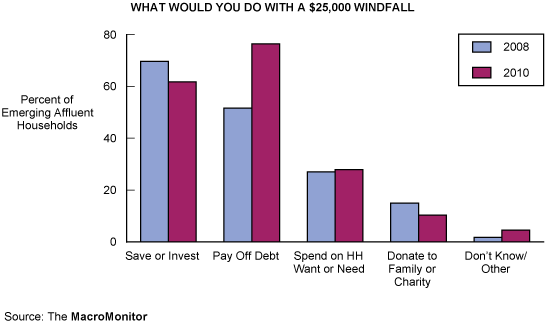MacroMonitor Market Trends April 2011
MacroMonitor Market Trends is a newsletter from Consumer Financial Decisions that highlights topical news and trends of interest to you and your colleagues. If you would like more information about the topic in the newsletter or would like to discuss other ways that we can assist you in your research and marketing efforts, please contact us.
Uh-Oh! Are the Emerging Affluent the Last Bastion of the Middle Class?
The recession fallout has highlighted the growth of financial polarization in the United States. Various experts express concerns about the shrinking middle class and the implications for the United States. This issue should be of particular concern to financial-services providers because tomorrow's wealthy will come from today's upper-middle class. Postrecession changes indicate that households are concentrating their services into fewer financial relationships and staying with them longer. Emerging Affluent households are households with incomes of $100K or more or with assets of $500K or more (excluding their home) but not with investable assets of over $300K or more than $200K in home equity. They are solid upper-middle-class households. If the Emerging Affluent represent the last bastion of this segment of society—and we believe they do—then institutions that want their customer relationships to be "sticky" should make every possible effort now to engage these households before other providers attract them.
Institutions with wide product offerings can deliver where the majority of Emerging Affluent households are focused: on debt reduction. Good reason exists for this focus on debt: Higher proportions of Emerging Affluent have first mortgages, second mortgages, and vehicle and consumer loans than do all other households; almost 90% have at least one outstanding loan or line of credit.
Pre- and postrecession MacroMonitor measures reveal that in 2010, Emerging Affluent households are significantly more focused on reducing outstanding debts than previously. If they were to receive a $25,000 windfall, over three-quarters would use the money to pay off debt, in comparison with only half of households that said they would do so in 2008.

How have these households changed? And how can financial providers use the information to capture relationships with the Emerging Affluent as they transition into wealth? To learn more about how the MacroMonitor can help you identify and understand better Emerging Affluent households that represent business opportunities, please contact CFD.